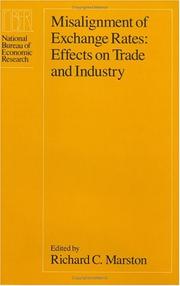| Listing 1 - 1 of 1 |
Sort by
|

ISBN: 0226507238 9786611431037 1281431036 0226507254 9780226507255 9780226507231 Year: 1988 Publisher: Chicago (Ill.): University of Chicago press,
Abstract | Keywords | Export | Availability | Bookmark
 Loading...
Loading...Choose an application
- Reference Manager
- EndNote
- RefWorks (Direct export to RefWorks)
Economists writing on flexible exchange rates in the 1960's foresaw neither the magnitude nor the persistence of the changes in real exchange rates that have occurred in the last fifteen years. Unexpectedly large movements in relative prices have lead to sharp changes in exports and imports, disrupting normal trading relations and causing shifts in employment and output. Many of the largest changes are not equilibrium adjustments to real disturbances but represent instead sustained departures from long-run equilibrium levels, with real exchange rates remaining "misaligned" for years at a time. Contributors to Misalignment of Exchange Rates address a series of questions about misalignment. Several papers investigate the causes of misalignment and the extent to which observed movements in real exchange rates can be attributed to misalignment. These studies are conducted both empirically, through the experiences of the United States, Great Britain, Japan, and the countries of the European Monetary System, and theoretically, through models of imperfect competition. Attention is then turned to the effects of misalignment, especially on employment and production, and to detailed estimates of the effects of changes in exchange rates on several industries, including the U.S. auto industry. In response to the contention that there is significant "hysteresis" in the adjustment of employment and production to changes in exchange rates, contributors also attempt to determine whether the effects of misalignment can be reversed once exchange rates return to earlier levels. Finally, the issue of how to avoid-or at least control-misalignment through macroeconomic policy is confronted.
International finance --- Foreign exchange --- Congresses. --- 339.74 --- -AA / International- internationaal --- 334.151.27 --- 333.450 --- AA / International- internationaal --- 333.825 --- 333.44 --- Proceedings of a conference held in Cambridge, Mass., on 7-8 May 1987. --- NBB congres --- Cambistry --- Currency exchange --- Exchange, Foreign --- Foreign currency --- Foreign exchange problem --- Foreign money --- Forex --- FX (Finance) --- International exchange --- Currency crises --- Monetaire buitenlandse politiek. Deviezenpolitiek --- Congresses --- Europees monetair stelsel. --- Theorie van het deviezenverkeer. Theorie van de koopkrachtpariteit. --- Deviezenpolitiek. Interventies. --- Monetaire congressen, conferenties en onderzoeken. --- 339.74 Monetaire buitenlandse politiek. Deviezenpolitiek --- Proceedings of a conference held in Cambridge, Mass., on 7-8 May 1987 --- Monetaire congressen, conferenties en onderzoeken --- Theorie van het deviezenverkeer. Theorie van de koopkrachtpariteit --- Deviezenpolitiek. Interventies --- Europees monetair stelsel --- Economic conditions --- Effects of variation in foreign exchange rates --- E-books --- Foreign exchange - Congresses. --- trade, industry, exchange rates, finance, economics, economy, economists, relative prices, exports, imports, employment, output, labor, work, equilibrium levels, misalignment, united states of america, american, japan, japanese, great britain, british, european monetary system, imperfect competition, production, macroeconomic policy, variability, payments, dollar, manufacturing, devaluation, adjustment process.
| Listing 1 - 1 of 1 |
Sort by
|

 Search
Search Feedback
Feedback About
About Help
Help News
News